
| Tikal Scientific Information Center |
Tikal's Meteorological Information | Tikal's Hydrology | Tikal's Ecology | Tikal's Flora | Tikal's Fauna |
| Tikal's Mammals | Tikal's Felines | Tikal's Bats | Tikal's Birds | Tikal's Insects | Tikal's Reptiles | Tikal's Amphibians |
| Tough to Spot |
Resident Bird Species at the Tikal National Park in Guatemala
Ocellated Turkey
Order: Galliformes
Family: Phasianidae
Species: Meleagris ocellata
It is one of the most beautiful birds you will see in Tikal. It is smaller than the common turkey, with bright blue and distinctive long, rounded tail feathers marked near the tip with blue and bronze eyespots. These spots shimmer with a brilliant greenish iridescence when they catch the sunlight. The ocellated turkey makes a curious sound, a slightly nasal, hesitant “puhk-puhk”…which accelerates into a roll or gobble, which sounds a bit like a motor-scooter starting up. Its habitat is humid to semi-humid deciduous forest and clearings, overgrown milpas (corn fields) and brushy woodlands.
They usually live in small groups. The ocellated turkey is found only in northeastern Petén in Guatemala. They are pretty tame in Tikal and common, but are elusive and wary in most of their range. They have become almost extinct in much of their former range, which included Belize and the Yucatan Peninsula; due to being an easy catch for hunters. No serious prize hunter would try to collect an ocellated turkey as a prize, as would no taxonomist, as it is one of only two wild turkey species in the world.
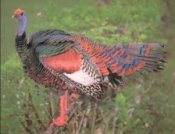
Blue- Crowned Motmot
Order: Coraciiformes
Family: Momotidae
Species: Momotus momota
The Blue-Crowned Motmot has red eyes and a deep blue, almost black crown, broadly encircled by turquoise-blue and a black turquoise mask. It has a green nape and upper parts, with bluer flight feathers and its tail is made of a pair of black-tipped blue rackets. Its throat and under parts are greenish olive to greenish cinnamon, the shin is pale turquoise with 2 black chest spots.
Its voice is a distinctive and low double “hoot-oot” or “hoop-hoop”, and it is often heard before dawn, suggesting an owl; at times they only sing a single hoot, or several hoots in series if there are 2 or 3 birds together. They live in humid and semiarid open woodland forest and edges, clearings with scattered trees, plantations and gardens.
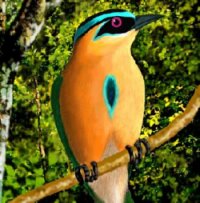
Keel-Billed Toucan
Order: Piciformes
Family: Ramphastidae
Species: Ramphastos sulfuratus
Toucans are abundant and fairly common in the lowland tropical rainforests of Guatemala. They prefer to live in tall trees, and especially on those that bear nuts and fruit. They have stubby wings and tend to swoop as they fly, owing to the weight of their bill, a red-tipped, canoe-like apple-green appendix, with an orange triangle on top and a streak of powder blue below. Green around its eyes and yellow on the collar, the toucan has a black body and a bright yellow chest, with a bright red patch beneath the tail and a white patch above it. The legs and feet are blue. The habitat where these birds live is humid evergreen forests and edges, and semi open areas with forest patches.
Their flight is undulating and often high, their rapid flaps are interspersed with sailing glides. Their wing’s beats make a loud rushing sound at a close range. At mid to upper levels, they are often on prominent base snags, in pairs or small groups. Their voice is a low, throaty and frog-like note, repeated, “rrk,rrk,rrk”…
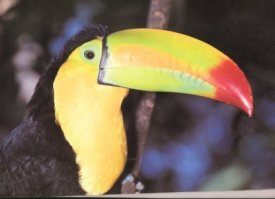
Collared Aracari
Order: Piciformes
Family: Ramphastidae
Species: Pteroglossus torquatus
The other attractive toucan, that looks like a toucan, but is black with orange and yellow under parts is called an araçari toucan. Their eyes are pale yellow with the orbital skin around them black and red, the bill black below, pale greyish above with a dark tip and a purplish flush at the base, their legs are blue-grey. Its head, upper chest and upper parts are black with a narrow maroon hind collar. The rest of its under parts are yellow, they are mottled red on their chest, with a black chest spot and bellyband, their thighs are chestnut-brown, and the underside of their tails a greenish hue. This bird’s habitat is humid to semi humid forests and edges, plantations and second growth woods. Their voice is a high, sharp squeaky “pi-cheet” or “squi-zeek”, not usually repeated steadily, and it may recall the sound made by the Grove-billed Ani.
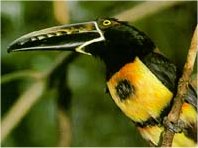
Collared aracari, Pteroglossus torquatus
Pale-Billed Woodpecker
Order: Piciformes
Family: Picidae
Species: Campephilus guatemalensis
There are several woodpeckers in Tikal… we have chosen two of the easiest to spot to present to you! One is the Pale billed woodpecker; it has a red head and black neck, chest, and under parts, and it has a white line down the neck’s sides that run into a closed white scapular. Its underbody is barred black and whitish. The voice of the Pale billed woodpecker is sharp, nasal, and sometimes like a squirrel’s cluck. It drums a distinctive, loud, rapid double rap, less often up to 7 distinct raps in rapid, resonant series. Local belief has it that when you see one it means that you will meet a woman or receive a woman visitor…
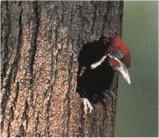
Pale billed woodpecker, Campephilus guatemalensis
Chestnut-Colored Woodpecker
Order: Piciformes
Family: Picidae
Species: Celeus elegans
The other is the Chestnut-colored woodpecker, also known as the hippie woodpecker in Tikal. It has an ochre head and crest with a red patch below its eyes, the rest of its plumage is chestnut brown, coarsely scalloped and barred black except on its flight feathers; primaries and tail dark distally. The voice of this bird is a sharp, slightly explosive, hollow “whehoo!” or “kyow”, at times followed by a laughing series of 2-10 notes. Their habitat is humid evergreen and semi deciduous forest. It is fairly active, mostly at mid to upper levels.
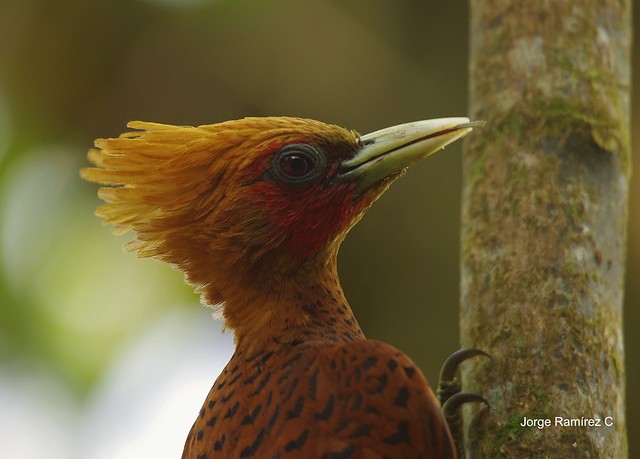
Chestnut woodpecker, Celeus elegans
Photo by Jorge Ramirez
Montezuma’s Oropendola
Order: Passeriformes
Family: Icteridae
Species: Psarocolius montezuma
The Montezuma Oropendola’s song is an unforgettable, bizarre gurgling and hollow popping series of squeaky “woik- woik”s, a low “chuck” or “whek,” often a “gruff”, a sneezy “rruh”, a cooing, a slightly clucking “whi-t-wuuu”, and a gruff clucking “kyuk kyuk”…They then look as though they are going to fall of the branch on which they stand. If this sound description isn’t enough, their long hanging nests will make them easily identifiable.Its blue-black and orange-tipped bill characterizes the Oropendola.
It has a chestnut overall, becoming blackish on the head, with blackish central rectrices on its tail. The rest of its tail is bright yellow. Its legs are dark grey.
They live in humid evergreen forests and on the adjacent open areas with hedges and scattered trees. They are arboreal, live in small groups and at times in flocks of up to 100 or more birds; in full display females swing upside down and flash their yellow under parts in their raised tails. Their flight is slow and steady.
There are some parasitic species which tend to nest in the Oropendola’s home, such as the cow-bird. Female Oropondolas make their nests, which males put through a test, to see if they will hold up for laying their eggs and if they do, then they will mate.
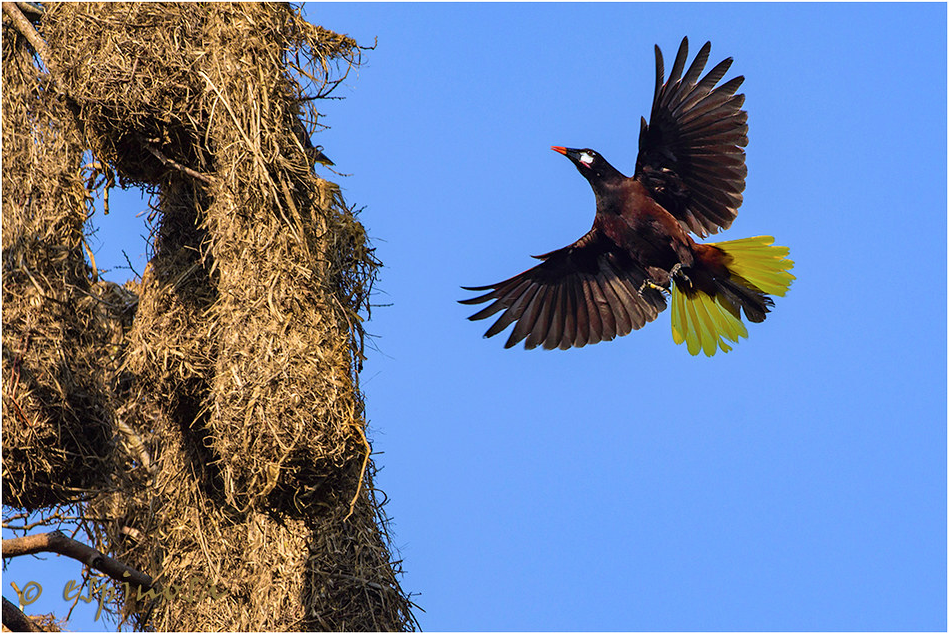
Montezuma's Oropendola, Psarocolius montezuma
Photo by Mario Espinosa


Birds are endotherm (warm-blooded) animals. They have vertebrae, lay eggs and are distinguished by the possession of feathers, wings, a beak, and typically by being able to fly.
Class "Aves" birds probably evolved in the Jurassic period from small dinosaurs that may already have been endotherm (warm-blooded).
We hope you will enjoy www.tikalpark.com and its Spanish version www.parque-tikal.com
For reservations or more information write to us at tikalpark@tikalpark.com


| Home | Arts | Sciences | Transportation | Lodging | Special Tours | Birding Tours | Tours | Map | About Us | e-mail us | Site Map |